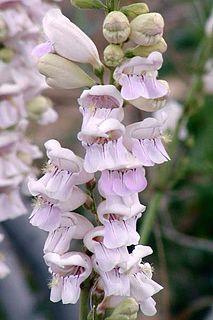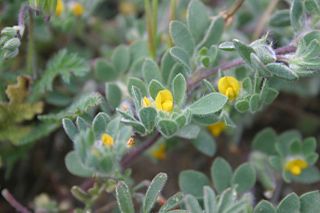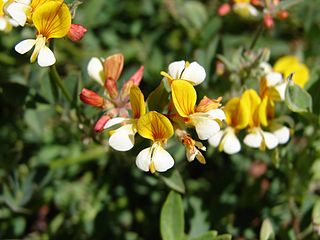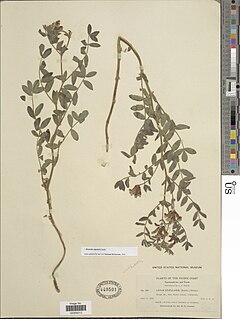
Penstemon, the beardtongues, is a large genus of roughly 250 species of flowering plants native mostly to the Nearctic, but with a few species also found in the North American portion of the Neotropics. It is the largest genus of flowering plants endemic to North America. Formerly placed in the family Scrophulariaceae by the Cronquist system, new genetic research has placed it in the vastly expanded family Plantaginaceae.

Lupinus, commonly known as lupin, lupine, or regionally bluebonnet etc., is a genus of flowering plants in the legume family Fabaceae. The genus includes over 199 species, with centers of diversity in North and South America. Smaller centers occur in North Africa and the Mediterranean. They are widely cultivated, both as a food source and as ornamental plants, but are invasive to some areas.

Lotus, a latinization of Greek lōtos, is a genus of flowering plants that includes most bird's-foot trefoils and deervetches and contains many dozens of species distributed worldwide. Depending on the taxonomic authority, roughly between 70 and 150 are accepted. Lotus is a genus of legumes and its members are adapted to a wide range of habitats, from coastal environments to high altitudes.
Hosackia crassifolia, synonym Lotus crassifolius, is a species of legume native to Washington, California and Oregon. It is known by the common names big deervetch and broad-leafed lotus.

Acmispon argophyllus, synonym Lotus argophyllus, is a species of legume native to California and northwest Mexico. It is known by the common name silver bird's-foot trefoil or silver lotus.

Acmispon cytisoides, synonyms Lotus benthamii and Syrmatium cytisoides, is a species of legume native to California. It is known by the common names Bentham's broom and Bentham's deerweed. It is endemic to central California, where it occurs along the Central Coast and into the coastal mountain ranges. It grows in oceanside habitat and inland on slopes and in canyons. It is a mat-forming or spreading perennial herb lined with leaves each made up of a few oval leaflike leaflets up to 12 mm long. The inflorescence bears up to 10 dull pinkish dark-veined flowers, each just under 1 cm long.

Acmispon dendroideus, synonym Syrmatium veatchii, is a species of legume native to California. It is known by the common name island broom. It is endemic to the Channel Islands of California, where it grows on coastal bluffs and cliffs. It is a spreading perennial herb or erect shrub approaching 2 meters in height. It is hairless to hairy and gray-green in color. The branches lined with leaves each made up of a few oval leaflike leaflets up to 1.5 centimeters long each. The inflorescence bears up to 10 yellow pealike flowers, each roughly a centimeter long and fading red as they age.

Hosackia gracilis, synonym Lotus formosissimus, is a species of legume native to western North America from British Columbia through Washington and Oregon to California. It was first described by George Bentham. It is known by the common names harlequin lotus and seaside bird's-foot trefoil. It grows in moist spots in the coastal mountains and down to the oceanside bluffs. It is a perennial herb growing upright or spreading to about 0.5 m in maximum length. It is lined with leaves each made up of a few oppositely arranged oval leaflets up to 2 cm long. The inflorescence is made up of several pealike flowers each 1 to 2 cm long. The flower has a bright yellow banner, or upper petal, and bright pink or white lower petals. The fruit is a legume pod 2 to 3 cm long.

Acmispon grandiflorus, synonym Lotus grandiflorus, is a species of legume native to western North America. It is known by the common name chaparral bird's-foot trefoil.
Acmispon haydonii, synonyms Lotus haydonii and Syrmatium haydonii, is a species of legume native to California It is known by the common names pygmy lotus, rock bird's-foot trefoil and Haydon's lotus.

Acmispon brachycarpus is a species of legume known by the common name foothill deervetch. It is native to western North America from Idaho to Texas to northern Mexico, where it is known from many types of habitat. It is an annual herb spreading upright or taking a clumpy or matted form. It is lined with leaves each usually made up of four hairy, somewhat fleshy leaflets each up to about 1 cm long. Solitary yellow, pea-like flowers appear in the leaf axils. The fruit is a legume pod variable in size and shape.
Acmispon junceus, synonyms Lotus junceus and Syrmatium junceum, is a species of legume native to California. It is known by the common names rush broom and rush deervetch. It is endemic to California, where it is known from the northern and central coast and the coastal mountain ranges. It can be found from beaches inland to serpentine slopes and chaparral. It is a hairy, prostrate or spreading perennial herb lined with leaves each made up of small oval leaflets. The inflorescence bears up 8 yellow pealike flowers each up to about a centimeter long. The fruit is a small beaked legume pod.

Acmispon parviflorus, synonym Lotus micranthus, is a species of legume. It is known by the common name desert deervetch. It is native to western North America from British Columbia to southern California, where it is known from many types of habitat. It is a hairy to hairless annual herb lined with leaves each made up of small oval leaflets. Solitary flowers appear in the leaf axils. Each is an ephemeral pinkish pealike bloom under a centimeter long. The fruit is a narrow, hairless, wavy-edged legume pod up to about 2.5 centimeters long.

Hosackia oblongifolia, synonym Lotus oblongifolius, is a species of legume native to western North America from Oregon to northern Mexico. It is known by the common name streambank bird's-foot trefoil or meadow lotus. It grows in moist to wet areas in several types of habitat. It is a spreading or upright perennial herb lined with leaves each made up of 3 elongated oval leaflets each up to 2.5 centimeters long. The inflorescence bears several yellow and white flowers between 1 and 2 centimeters long. The fruit is very elongated, reaching up to 5 centimeters in length but just a few millimeters in width.

Acmispon maritimus, synonym Lotus salsuginosus, is a species of legume native to Arizona, California and northwestern Mexico. It is known by the common name coastal bird's-foot trefoil. It grows in many types of mountain, desert, and scrub habitat, not necessarily near the coast. It is an annual herb quite variable in morphology, from petite to bushy, hairless to roughly hairy, and prostrate to erect in form. The slender stems are lined with leaves each made up of pairs of leaflets variable in shape and size. The inflorescence is a small array of 1 to 4 yellow flowers, each up to a centimeter long or so. The elongated flower corolla emerges from a tubular calyx of sepals. The fruit is a legume pod up to 3 centimeters long. Laboratory studies have shown this species, which occurs in wildfire-prone habitat such as chaparral, to have an increased rate of seed germination after exposure to heat.

Hosackia stipularis, synonym Lotus stipularis, is a species of legume endemic to California. It is known by the common name balsam bird's-foot trefoil. It is found in most of the northern and central coastal and inland mountain ranges and foothills. It can be found in many types of habitat, including forest, chaparral, and disturbed areas. This is a mostly erect perennial herb with a leafy, often hairy and glandular form. Its slender branches are lined with leaves each made of several leaflets up to 2 centimeters long. The leaves sometimes have prominent stipules. The inflorescence is a compact array of up to 9 pink flowers. Each flower is elongated, the corolla borne in a tubular calyx of sepals, and the entire unit may exceed a centimeter long. The fruit is a legume pod 2 or 3 centimeters long containing several beanlike seeds.

Acmispon is a genus of flowering plant in the family Fabaceae (legumes), native to North America and the west coast of Chile in South America. It includes several species of American bird's-foot trefoils and deervetches formerly contained in the globally distributed genus Lotus. The former genus Syrmatium is included in Acmispon. The Jepson eFlora accepts only Acmispon.

Hosackia is a genus of flowering plants in the family Fabaceae (legumes). It is native to western North America, from British Columbia in Canada to Mexico.

Syrmatium was a formerly accepted genus of flowering plants in the family Fabaceae (legumes), native to the southwestern United States. As of February 2021, it was considered a synonym of Acmispon by Plants of the World Online, and only Acmispon was recognized by the Jepson eFlora.

Anstruther Davidson (1860–1932) was a Scottish-American physician, professor of medicine, botanist, and entomologist.















